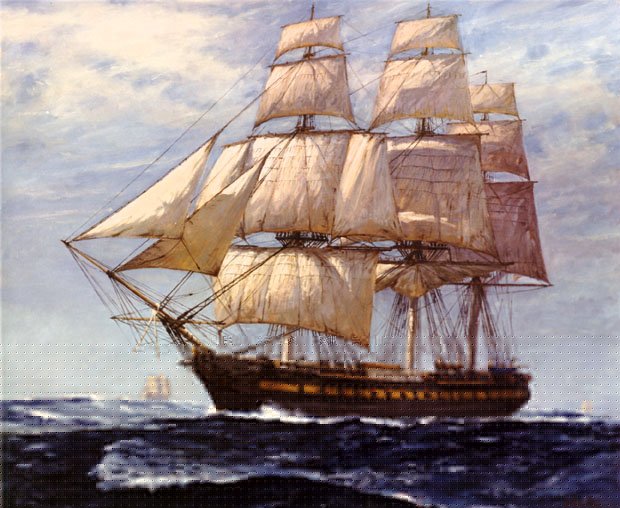|
https://en.wikipedia.org/wiki/List_of_War_of_1812_battles
CLICK HERE
CHRONOLOGY EVENTS --DAY BY DAY DON'T LNK
LEAVE FOR ANY USE?
OPEN HERE
July 16, 1812
War on land and at sea-The Constitution
Today, news of the war reaches Thunder Bay, Ontario. A force of about 280 troops under the command of Col. Louis Cass (part of Brig. Gen's William Hull's army) attack the British command stationed just south of Fort Malden on the Canard River in Ontario. The British force, which consists of the 41st Regiment, Indians, and Canadian militia, have established an outpost at a nearby bridge, which the Americans assault. After a brief stand, the outnumbered British will fall back towards the fort.
At sea, a British squadron captures the U.S. brig, Nautilus, in the North Atlantic. Elsewhere in the Atlantic aboard Constitution (pictured), at 2 p.m. her lookout sights four unknown sails. In pursuit by 4 p.m. Constitution, sees a ship standing towards it and possibly others near shore. Thinking them possibly Commodore Rogers' squadron, Constitution stands toward the easternmost sail at 6:15 p.m. At 7:30 p.m. Captain Isaac Hull gives the order for the ship to beat to quarters. After approaching within six or eight miles of the ships and not receiving a response to the private signal, Hull at 11:15 p.m. determines that the strange sails belong to the enemy. However, he decides to avoid action until daylight in order to spare his untrained crew from the confusion of a nighttime engagement, and turns away into the Atlantic.
July 17, Morning dawns for Constitution and its crew
In the Atlantic aboard Constitution, no wind at sunrise on this morning; becalmed, the ship is rendered unmanageable. With daylight, Captain Isaac Hull determines that his ship is being pursued by a ship-of-the-line, three frigates (including the Guerriere), a brig, and a schooner flying English colors 6-10 miles away. Desperately pursuing all means of escape, Hull ordered his crew to pump water overboard ito lighten the ship, and to wet the sails, which closes the texture of the canvas, thus eking out every small advantage of breeze possible. Constitution's reputation as a poor sailer convinces some of the crew that the situation is hopeless. Keeping out of firing range to prevent being overtaken, Hull, encouraged by Lieutenant Charles Morris, resorts to kedging his ship. Seamen row a longboat containing a small anchor out the distance of a cable, drop it, and the crew aboard ship manually haul in the ship with the capstan. Hull has little choice but to risk this maneuver or chance being trapped against the coast. The Americans begin kedging at 7:00 a.m. and the British follow suit once they find themselves becalmed as well. Having more men and boats, the British concentrate on towing those ships closest to Constitution and thus hold a decided advantage in closing within firing range. Besides lowering two cutters to tow the ship, Constitution's crew hoists a 24-pounder from the gun deck to the spar deck and position it at the taffrail along with an 18-pounder to serve as stern chasers. An additional two 24-pounders are pointed out the captain's cabin windows, also to act as stern chasers. At 9:00 a.m., HMS Belvidera fires its bow guns and Guerriere delivers a broadside. The shots fall short, whereas the shot from Constitution's stern chasers is thought to strike Belvidera. All continue kedging but neither side gains ground. To lighten the ship, Hull pumps over 2,300 gallons of drinking water overboard. To improve their chances of overtaking Constitution, the British decide to put all their efforts in kedging one frigate, HMS Shannon. Throughout the day on the 17th, Constitution's crew members alternate between towing and resting; the crew's exertions prolong the Constitution's survival throughout the day and into the night.
Elsewhere: July 17, 1812
British attack, seize Michigan Fort Mackinac
Charles Roberts arrives at the American outpost Fort Mackinac, in Michigan, at 3:00 a.m., with 600 British, Canadians and Indian allies from Fort St. Joseph in Ontario. A local fur-trader quietly awakens the townspeople near the fort – who, because of the fort's remote location are unaware of the outbreak of war – and moves them to an old distillery for their protection. American Lt. Porter Hanks, outnumbered, facing two 6-pounder field guns, and fearful that the American Indians would slaughter everyone in the fort, wisely surrenders without a fight. The British will hold the fort for the next two years, until an American attempt to retake it.
|

